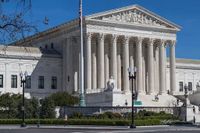On August 21, 2025, the U.S. Supreme Court delivered a decision that sent ripples through the scientific and public health communities, pausing a lower court order and effectively allowing the Trump administration’s controversial termination of over $780 million in National Institutes of Health (NIH) grants to stand—at least for now. The grants in question were tied to diversity, equity, and inclusion (DEI), gender identity, and vaccine hesitancy research, all of which had become flashpoints in the ongoing debate over the direction of federal science funding.
The Supreme Court’s 5-4 vote, as reported by multiple outlets including The Sunday Paper and JURIST, temporarily halted a ruling from the U.S. District Court for the District of Massachusetts. That lower court had previously sided with a coalition of 16 states and the American Public Health Association (APHA), who argued that the abrupt ending of these grants violated both the Constitution and the Administrative Procedures Act (APA). Judge William Young, who presided over the case, acknowledged the right of a new administration to make policy changes but emphasized, “a new administration certainly is entitled to make changes—even unpopular or unwise changes—but it cannot undertake actions that are not reasonable and not reasonably explained.”
The legal battle stems from an executive order signed by President Donald Trump at the outset of his term, titled “Ending Radical and Wasteful Government DEI Programs and Preferencing.” The order instructed several federal agencies—including the NIH—to dismantle DEI programs and cease funding for research related to DEI objectives, gender identity, and COVID-19. Internal guidance from the NIH reflected this shift, stating explicitly, “the agency will not fund research related to DEI objectives, gender identity, or COVID–19. Nor will it continue the practice of awarding grants to researchers based on race.”
As the NIH began implementing these directives, the impact was immediate and severe. Over $780 million in grants were canceled, affecting research projects across the country. The affected states and APHA quickly mounted a legal challenge, asserting that the terminations were not only abrupt but also lacked the transparent reasoning and process required by law. The district court agreed, but the Trump administration, through U.S. Solicitor General D. John Sauer, sought emergency relief from the Supreme Court after the First Circuit Court of Appeals refused to halt the lower court’s order.
Justice Amy Barrett’s concurring opinion in the Supreme Court’s ruling provided a nuanced legal roadmap for the ongoing dispute. She clarified that challenges to the NIH’s internal guidance documents fall under the APA and are properly heard in district court, while disputes over the actual termination of grants—essentially contract disputes—should be brought before the Court of Federal Claims. “These are legally distinct claims that require separate judicial forums, even if they arise from related facts,” Barrett wrote, underscoring the complexity of the legal terrain.
For researchers and public health advocates, the Supreme Court’s decision is both a setback and a temporary reprieve. While it allows the Trump administration’s grant cancellations to remain in effect for now, it does not close the door on future legal challenges. As The Sunday Paper summarized, “canceled grants won’t be immediately reinstated, while future cancellations may be blocked and legal challenges can proceed.” The ruling also leaves open the possibility that, should the legal challengers ultimately prevail, some of the affected research could resume—though the timeline for such an outcome remains uncertain.
Meanwhile, the NIH finds itself at the center of a political storm. The agency is responsible for distributing thousands of grants each year, many of which fund critical research into cancer, infectious diseases, and public health. The magnitude of the proposed cuts—nearly 40% of the NIH’s budget, according to recent White House proposals—has alarmed lawmakers on both sides of the aisle. U.S. Representative Chuck Fleischmann, a Republican from Ooltewah, Tennessee, publicly announced his support for continued funding of cancer research in direct opposition to the White House’s proposed cuts. “I’ll support funding cancer research,” Fleischmann stated, drawing a clear line between his stance and the administration’s efforts to slash NIH spending.
The political and legal wrangling over NIH funding comes at a time when the scientific community is already grappling with the aftershocks of the COVID-19 pandemic. While the Supreme Court’s ruling was narrowly focused on DEI, gender identity, and vaccine hesitancy research, the broader message is clear: federal science funding is increasingly subject to the shifting winds of political ideology. The Trump administration’s executive order framed DEI initiatives as “radical and wasteful,” a characterization that critics argue ignores the proven benefits of diversity in scientific research and the urgent need for continued work on vaccine hesitancy and public health disparities.
For researchers whose work has been disrupted or defunded, the stakes are deeply personal. Many spent years building research teams and infrastructure based on multi-year NIH grants, only to see their funding vanish overnight. Public health advocates warn that the loss of research on vaccine hesitancy and gender identity could have real-world consequences, particularly for marginalized communities already facing barriers to healthcare access. The APHA and the coalition of states have vowed to continue their fight in the courts, arguing that the government’s actions are not only harmful but also unlawful.
The legal distinctions outlined by Justice Barrett may ultimately shape the path forward. If the courts determine that the NIH’s internal guidance violated the APA, some aspects of the executive order could be overturned, potentially restoring funding for certain types of research. On the other hand, if the dispute over terminated grants is relegated to the Court of Federal Claims, affected researchers may face a lengthy and uncertain legal process to recover lost funding.
While the Supreme Court’s decision is not the final word, it sets the stage for a protracted legal and political battle over the future of federal science funding. Lawmakers like Rep. Fleischmann are already signaling that NIH’s role in supporting vital research—especially in areas like cancer—will be a flashpoint in upcoming budget debates. As the scientific community waits for resolution, the broader public is left to wonder: What kinds of research will the government choose to support in the years ahead, and who will decide?
In the weeks and months to come, the outcome of this case could reshape the landscape of American science and public health. For now, the fate of hundreds of millions of dollars in NIH grants—and the research they support—hangs in the balance, a vivid reminder of how deeply politics and policy are intertwined in the world of scientific discovery.

